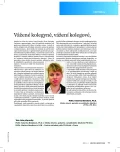Can we predict mortality in elderly patients with Clostridium difficile infection?
Authors:
K. Bielaková
Published in:
Geriatrie a Gerontologie 2016, 5, č. 4: 177-180
Category:
Original Article/Study
Overview
Background:
Clostridium difficile is an important cause of nosocomial infections and especially in geriatric patients those often have lethal consequences. The goal of this study was to evaluate the risk factors for mortality in CDI patients and to construct a binary logistic regression model which describes the probability of mortality in geriatric patients suffering from CDI.
Methods:
In this retrospective study the group of 235 patients over 65 years of age with confirmed diagnoses of CDI, hospitalised at the Department of Internal Medicine, Geriatrics and General Practice, Brno, from January 2008 to December 2013, were evaluated. The examined group consisted of 148 women (63 %) and 87 men (37 %). For the diagnosis of CDI, confirmation of A and B toxins in the patients’ stool or autopsy confirmation was crucial.
Results:
Our binary regression model consisted of a combination of the following parameters: the number of antibiotics used from patients history, nutritional status (Mini Nutritional Assessment short-form test), presence of pressure ulcers, and occurrence of fever.
Conclusion:
Our logistic regression model may predict mortality in geriatric patients suffering from CDI. This could help improving the therapeutic process.
KEYWORDS:
Clostridium difficile – geriatric patient – binary logistic regression model
Sources
1. Jones MA, Kuijper EJ, Wilcox MH. Clostridium difficile: a European perspective. J Infect 2013; 66(2): 115–128.
2. Depestel DD, Aronoff DM. Epidemiology of Clostridium difficile infection. J Pharm Pract 2013; 26(5): 464–475.
3. Cober ED, Malani PN. Clostridium difficile infection in the “oldest” old: clinical outcomes in patients aged 80 and older. J Am Geriatr Soc 2009; 57(4): 659–662.
4. Dupont HL, Garey KW. Clostridium difficile infection: an emerging epidemic with more questions than answers. Future Microbiol 2010; 5(8): 1153–1156.
5. Raveh D, Rabinowitz B, Breuer GS, Rudensky B, Yinnon AM. Risk factors for Clostridium difficile toxin-positive nosocomial diarrhoea. Int J Antimicrob Agents 2006; 28(3): 231–237.
6. Hall IC, O’Toole E. Intestinal flora in newborn infants with 1. description of a new pathogenic anaerobe. Am J Dis Child 1935; 49: 390–402.
7. Tedesco FJ, Barton RW, Alphers DH. Clindamycin-associated colitis. A prospective study. Ann Intern Med. 1974; 81(4): 429–433.
8. Khana S, Pardi DS. The growing incidence and severity of Clostridium difficile infection in inpatient and outpatient settings. Expert Rev Gastroenterol Hepatol 2010; 4(4): 409–416.
9. Rao K, Micic D, Cheoweth E, et al. Poor Functional Status as a Risk factor for Severe Clostridium difficile infection in hospitalized older adults. J Am Geriatr Soc 2013; 61(10): 1738–1742.
10. Zilberberg MD, Shorr AF, Kollef MH. Increase in adult Clostridium difficile-related hospitalizations and case-fatality rate, United States, 2000–2005. Emerg Infect Dis 2008; 14(6): 929–931.
11. Miller M, Gravel D, Mulvey M, et al. Health care-associated Clostridium difficile infection in Canada: patient age and infecting strain type are highly predictive of severe outcome and mortality. Clin Infect Dis 2010; 50(2): 194–201.
12. Lim WS, van der Eerden MM, Laing R, et al. Defining community acquired pneumonia severity on presentation to hospital: an international derivation and validation study. Thorax 2003; 58(5): 377–382.
13. Bauer MP, Hensgens MP, Miller MA, et al. Renal failure and leukocytosis are predictors of a complicated course of Clostridium difficile infection if measured on day of diagnosis. Clin Infect Dis 2012; 55(Suppl 2): S149–S153.
14. Miller MA, Louie T, Mullane K, et al. Derivation and validation of a simple clinical bedside score (ATLAS) for Clostridium difficile infection which predicts response to therapy. BMC Infect Dis 2013; 13: 148.
15. Boone JH, Archbald-Pannone LR, Wickham KN, et al. Ribotype 027 Clostridium difficile infection with measurable stool toxin have increased lactoferrin and are associated with a higher mortality. Eur J Clin Microbiol Infect Dis 2014; 33(6): 1045–1051.
16. Butt E, Foster J AH, Keedwell, E, et al. Derivation and validation of a simple, accurate and robust prediction rule for risk of mortality in patients with Clostridium difficile infection. BMC Infect Dis 2013; 13: 316.
Labels
Geriatrics General practitioner for adults Orthopaedic prostheticsArticle was published in
Geriatrics and Gerontology

2016 Issue 4
Most read in this issue
- Obstipation in the elderly
- Diabetes and dementia – what is known about their relationship?
- Acute and late onset complications of diabetes – do they pose a significant problem in the elderly?
- A cutaneous lymphomatic disease at geriatric patient
